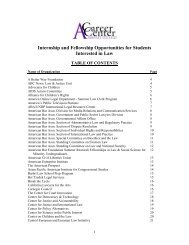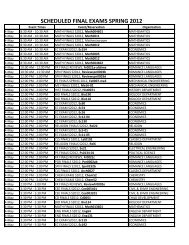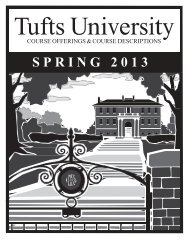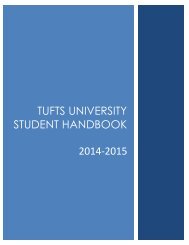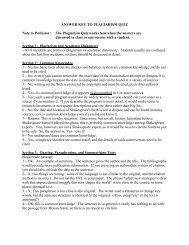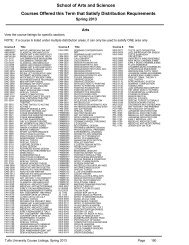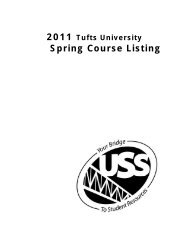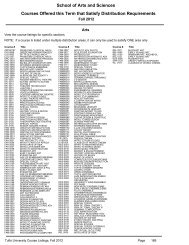2013â2014 The Bulletin - USS at Tufts - Tufts University
2013â2014 The Bulletin - USS at Tufts - Tufts University
2013â2014 The Bulletin - USS at Tufts - Tufts University
Create successful ePaper yourself
Turn your PDF publications into a flip-book with our unique Google optimized e-Paper software.
Archaeology ><br />
Architectural Studies ><br />
Sciences, and Archaeology may be considered for<br />
inclusion if approved by a faculty advisor in the<br />
archaeology program. Transfer courses from other<br />
institutions limited to two unless approved by<br />
advisor.)<br />
a. Two History courses taken from Cls 26, 37, 38,<br />
47, 85, 86, 142, 143, 144, 146, 147, 185, 186;<br />
Hist 6, 13, 17, 23, 40, 50, 51, 72, 76, 105, 148,<br />
149, 151<br />
b. Two N<strong>at</strong>ural/Social Science courses taken from<br />
Anth 40, 49 (formerly 20), 126, 132, 150, 182;<br />
Biology 7 or 10 (student may not count both<br />
Bio 7 and Bio 10), 143, 144; Chem 2, 8; Eos 32<br />
c. Three Archaeology courses taken from Arch 26,<br />
49, 51, 52, 91, 92, 128, 160, 163, 164, 167, 168,<br />
187, 188, 190, 191, 192; Classics 26, 87, 88, 160,<br />
163, 164, 167, 168, 187, 188; FAH 103, 104,<br />
105, 106<br />
III. Interdisciplinary Capstone (optional)—<br />
Archaeology 193 and 194 or other approved courses<br />
GRADUATE ProgrAM<br />
Master of Arts in Classical Archaeology<br />
(SEE CLASSICS FOR ProgrAM DESCRIPTION.)<br />
For more detailed inform<strong>at</strong>ion, please visit the<br />
website http://ase.tufts.edu/archaeology.<br />
Architectural Studies<br />
DIRECTOR (2013–14):<br />
Associ<strong>at</strong>e Professor Daniel Abramson, Art and Art History<br />
ADVISORY COMMITTEE:<br />
Robyn Gittleman, Director, Experimental College<br />
Professor Rachel Br<strong>at</strong>t, Urban and Environmental Policy<br />
and Planning<br />
Professor Masoud Sanayei, Civil and Environmental<br />
Engineering<br />
<strong>Tufts</strong> offers several curricular p<strong>at</strong>hs for students<br />
interested in the study of architecture and the built<br />
environment. <strong>The</strong> various curricular p<strong>at</strong>hs in<br />
architectural studies provide opportunities to study<br />
architecture as a liberal arts or engineering major or<br />
minor and, if desired, help prepare for future<br />
gradu<strong>at</strong>e study and careers in architecture and other<br />
allied disciplines, such as landscape architecture,<br />
urban planning, and historic preserv<strong>at</strong>ion. All the<br />
curricular p<strong>at</strong>hs emphasize architecture’s interdisciplinary<br />
character and take full advantage of course<br />
offerings in both the College of Liberal Arts and<br />
the School of Engineering.<br />
In addition to the courses of study outlined<br />
below, students interested in pursuing gradu<strong>at</strong>e<br />
studies in architecture should take one or two<br />
semesters of calculus (M<strong>at</strong>hem<strong>at</strong>ics 32-34) and<br />
physics (Physics 11-12), and are encouraged to take<br />
Drama 10 for public speaking.<br />
For more inform<strong>at</strong>ion, contact Professor Daniel<br />
Abramson (Art and Art History) or Professor<br />
Masoud Sanayei (Civil and Environmental<br />
Engineering).<br />
COLLEGE OF LIBERAL ArtS<br />
Major in Architectural Studies<br />
<strong>The</strong> Department of Art and Art History offers an<br />
interdisciplinary major in Architectural Studies for<br />
students in the College of Liberal Arts th<strong>at</strong> teaches<br />
students understanding of the built environment<br />
from multiple perspectives through the development<br />
of basic skills in analyzing, interpreting, engineering,<br />
designing, and engaging imagin<strong>at</strong>ively and actively<br />
with the current and historical built environment.<br />
<strong>The</strong> built environment is defined broadly, from<br />
stage scenery and interior design to civil engineering<br />
and urban planning, in order to reflect historical<br />
and contemporary experience and to encompass the<br />
richness of <strong>Tufts</strong>’ curricular assets, which besides the<br />
offerings of the Art and Art History Department,<br />
include the university’s School of Engineering, its<br />
gradu<strong>at</strong>e department in Urban and Environmental<br />
Policy and Planning, and its affili<strong>at</strong>ion with the<br />
School of the Museum of Fine Arts. <strong>The</strong> Architectural<br />
Studies major totals twelve courses: seven core<br />
classes and five multidisciplinary electives. <strong>The</strong><br />
major’s core curriculum provides a found<strong>at</strong>ion in art<br />
and architectural history and theory, in engineering<br />
and design, and in the humanistic and social science<br />
aspects of architecture. Architectural Studies majors<br />
then design their own elective program of upperlevel<br />
study from design<strong>at</strong>ed courses in architectural<br />
history, studio art, civil engineering, the humanities,<br />
and the social sciences. (Students may take no more<br />
than three half-credit courses towards the major’s<br />
requirements.) As a capstone, senior majors in their<br />
final semester complete a senior integr<strong>at</strong>ive project,<br />
either as an independent research project or an<br />
internship in a professional office. Several opportu-<br />
99



